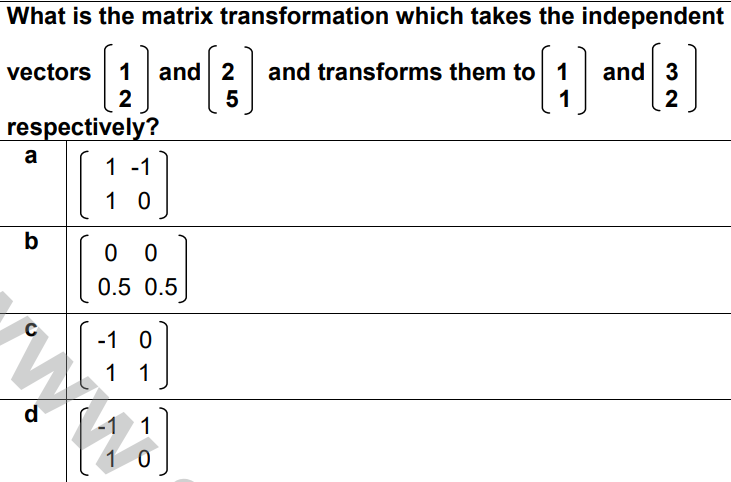Computer-Graphics
Question 1 |
Consider a raster grid having XY-axes in positive X-direction and positive upward Y-direction with Xmax = 10, Xmin = –5, Ymax = 11, and Ymin = 6. What is the address of memory pixel with location (5, 4) in raster grid assuming base address 1 (one) ?
A | 150 |
B | 151 |
C | 160 |
D | 161 |
Question 2 |
Consider a N-bit plane frame buffer with W-bit wide lookup table with W > N. How many intensity levels are available at a time ?
A | 2N |
B | 2 W |
C | 2 N+W |
D | 2 N-1 |
Question 3 |
Consider the Bresenham's line generation algorithm for a line with gradient greater than one, current point (xi, yi) and decision parameter, di. The next point to be plotted (xi+1, yi+1) and updated decision parameter, di+1, for di < 0 are given as _______.
A | xi+1 = xi +1 yi+1 = yi di+1 = di+ 2 dy |
B | xi+1 = xi yi+1 = yi +1 di+1 = di+ 2 dx |
C | xi+1 = xi yi+1 = yi +1 di+1 = di+ 2(dx -dy) |
D | xi+1 = xi +1 yi+1 = yi +1 di+1 = di+ 2(dy -dx) |
Question 3 Explanation:
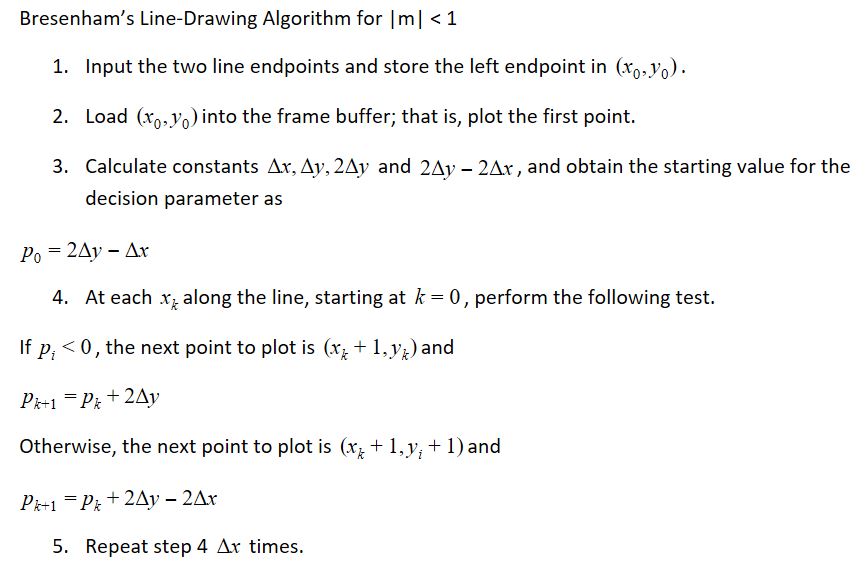
Question 4 |
A point P(2, 5) is rotated about a pivot point (1, 2) by 60°. What is the new transformed point P' ?
A | (1, 4) |
B | (–1, 4) |
C | (1, – 4) |
D | (– 4, 1) |
Question 4 Explanation:
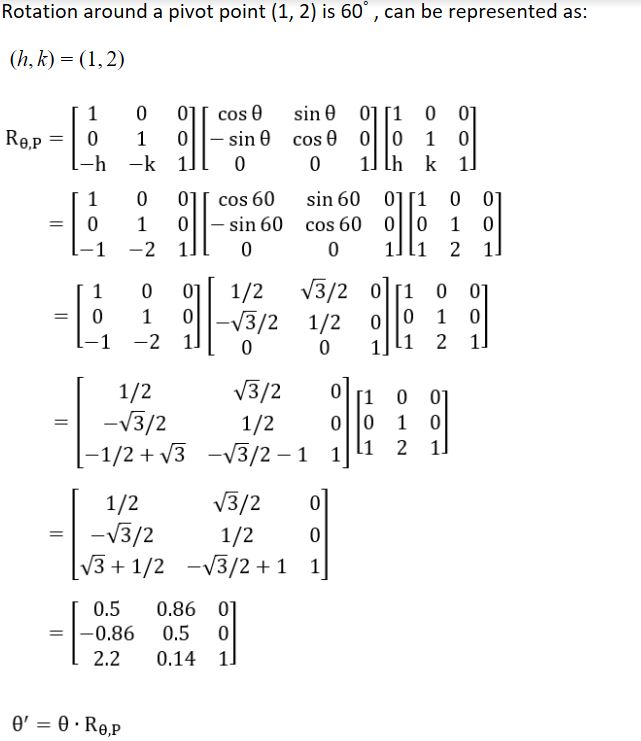
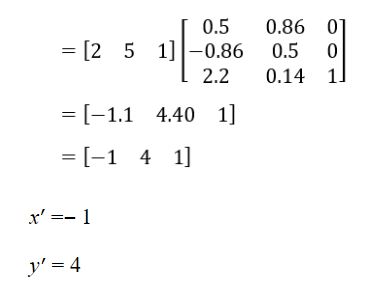
Question 5 |
In perspective projection (from 3D to 2D), objects behind the centre of projection are projected upside down and backward onto the view-plane. This is known as _____.
A | Topological distortion |
B | Vanishing point |
C | View confusion |
D | Perspective foreshortening |
Question 6 |
The Liang-Barsky line clipping algorithm uses the parametric equation of a line from (x1, y1) to (x2, y2) along with its infinite extension which is given as :
x = x1 + ∆x.u
y = y1 + ∆y.u
Where ∆x = x2– x1, ∆y = y2– y1, and u is the parameter with 0 ≤ u ≤ 1. A line AB with endpoints A(–1, 7) and B(11, 1) is to be clipped against a rectangular window with xmin = 1, xmax = 9, ymin = 2, and ymax = 8.
The lower and upper bound values of the parameter u for the clipped line using Liang-Barsky algorithm is given as :
x = x1 + ∆x.u
y = y1 + ∆y.u
Where ∆x = x2– x1, ∆y = y2– y1, and u is the parameter with 0 ≤ u ≤ 1. A line AB with endpoints A(–1, 7) and B(11, 1) is to be clipped against a rectangular window with xmin = 1, xmax = 9, ymin = 2, and ymax = 8.
The lower and upper bound values of the parameter u for the clipped line using Liang-Barsky algorithm is given as :
A | (0, 2/3) |
B | (1/6 , 5/6) |
C | (0, 1/3) |
D | (0, 1) |
Question 7 |
Given below are different properties of 3D projections from A.D. Identify the correct order on the basis of property true of
(i) a perspective projection only
(ii) an orthographic projection only
(iii) both orthographic and projective transformations and
(iv) neither orthographic nor projective transformation, respectively.
(A) Straight lines are mapped to straight lines.
(B) Distance and angles are (in general) preserved.
(C) Far away objects appear the same size as closer ones.
(D) Requires homogeneous coordinates in order for it to be encoded into linear transformation.
Choose the correct answer from the options given below:
A | D, C, B, A |
B | B, C, D, A
|
C | D, C, A, B |
D | C, D, B, A |
Question 8 |
Match List-I with List-II. List-I gives 33 matrices representing 2D transformations and List-II shows the corresponding transformation diagrams.
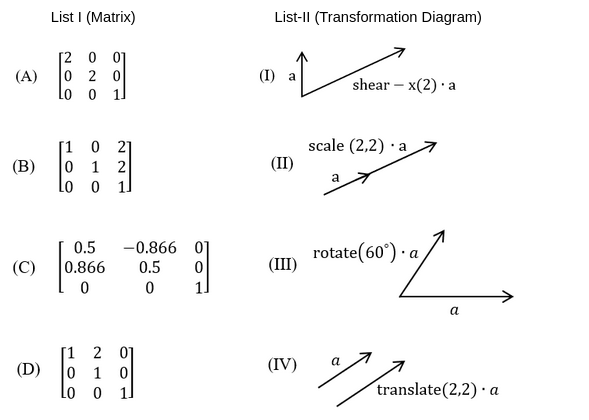
Choose the correct answer from the options given below:

Choose the correct answer from the options given below:
A | A-IV, B-II, C-III, D-I |
B | A-IV, B-III, C-II, D-I
|
C | A-III, B-II, C-IV, D-I |
D | A-II, B-IV, C-III, D-I |
Question 9 |
Given below are two statements:
Statement I: Bezier curves are curves that interpolate all of their control points
Statement II: A cubic bezier curve has four control points.
In the light of the above statements, choose the correct answer from the options given below
A | Both statement I and Statement II are true |
B | Both Statement I and Statement II are false |
C | Statement I is correct but Statement II is false |
D | Statement I is incorrect but Statement II is true |
Question 10 |
Concerning phong shading and gouraud shading in a 3D scene, which of the following statements are true?
(A) Gouraud shading requires more computation than phong shading
(B) Gouraud shading linearly interpolates the color of an interior pixel from the color at the vertices.
(C) Phong shading interpolates over the normal vectors specified at the vertices.
Choose the correct answer from the options given below:
A | (A) and (B) only |
B | (A) and (C) only |
C | (B) and (C) only |
D | (A), (B) and (C) |
Question 11 |
n the context of 3D Computer graphics, which of the following statements is/are correct?
A) Under perspective projection, each set of parallel lines in the object do not stay parallel in the image (except those that are parallel to the view plane to start with).
B) Applying a perspective transformation in the graphics pipeline to a vertex involves dividing by its ‘z’ coordinate.
C) Perspective transformation is a linear transformation.
Choose the correct answer from the options given below:
A | (A) and (B) only |
B | (A) and (C) only |
C | (B) and (C) only |
D | (A), (B) and (C) |
Question 12 |
Arrange the 2-D viewing transformation pipeline.
A. Convert to viewing coordinates
B. Map viewing coordinates to normalized viewing coordinates using window - viewpoint specifications
C. Construct world - coordinates scene using modeling - coordinates transformations
D. Map normalized viewpoint to device coordinates
Choose the correct answer from the options given below:
A. Convert to viewing coordinates
B. Map viewing coordinates to normalized viewing coordinates using window - viewpoint specifications
C. Construct world - coordinates scene using modeling - coordinates transformations
D. Map normalized viewpoint to device coordinates
Choose the correct answer from the options given below:
A | D,C,B,A
|
B | D,C,A,B
|
C | D,A,B,C |
D | B,C,A,D |
Question 13 |
The light given off by the phosphor during exposure to the electron beam is known as
A | Fluorescence |
B | Phosphorescence |
C | Persistence |
D | Retracing |
Question 14 |
The major adverse side effects of scan conversion are :-
A. Staircase appearance
B. Unequal brightness of slanted lines
C. Picket fence problem
D. Rasterization
E. Pre-filtering and Post-filtering
Choose the correct answer from the options given below:
A. Staircase appearance
B. Unequal brightness of slanted lines
C. Picket fence problem
D. Rasterization
E. Pre-filtering and Post-filtering
Choose the correct answer from the options given below:
A | A & B only |
B | A, B & C only |
C | B, C & D only |
D | C, D & E only
|
Question 15 |
Consider the rectangle with vertices (0,0),(0,2),(3,0),(3,2).There is a scaling of 2 towards the x-axis and 3 towards the y-axis. The new coordinates of the rectangle are
A | (0,0)(6,0)(0,4)(6,4)
|
B | (0,0)(6,0)(0,4)(3,2)
|
C | (0,0)(6,0)(0,6)(6,6)
|
D | (0,0)(4,0)(0,6)(4,6) |
Question 15 Explanation:
To scale a rectangle by a factor of 2 along the x-axis and 3 along the y-axis, you can apply the scaling factor to each vertex individually. The scaling operation multiplies the x-coordinate by 2 and the y-coordinate by 3 for each vertex.
Given the original vertices of the rectangle:
(0, 0)
(0, 2)
(3, 0)
(3, 2)
After scaling, the new coordinates are:
(0 * 2, 0 * 3) = (0, 0)
(0 * 2, 2 * 3) = (0, 6)
(3 * 2, 0 * 3) = (6, 0)
(3 * 2, 2 * 3) = (6, 6)
So, the correct new coordinates of the rectangle after scaling are:
(0, 0) (0, 6) (6, 0) (6, 6)
The option that matches these coordinates is:
(0, 0) (0, 6) (6, 0) (6, 6)
Question 16 |
The clipping process in computer graphics is used for
A | Adding graphics
|
B | copying
|
C | Zooming
|
D | removing objects and lines |
Question 16 Explanation:
The clipping process in computer graphics is used for removing objects and lines.
Clipping is a technique used to determine which portions of an object or line are visible and should be displayed within the boundaries of a given region or window.
Any part of an object or line that falls outside this region is "clipped" or removed, ensuring that only the visible portions are rendered on the screen.
This is a fundamental operation in computer graphics used to control what is displayed within a defined viewing area or viewport.
Question 17 |
Which of the following transforms in 2 dimension is used to resize a 2-dimensional object?
A | Translation
|
B | Rotation
|
C | Scaling
|
D | Shearing |
Question 18 |
This transformation is called
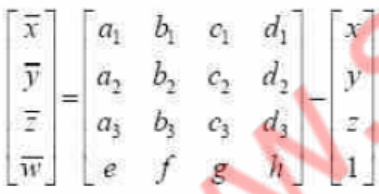

A | Scaling |
B | Shear |
C | Homography |
D | Steganography |
Question 19 |
Consider the following statements:
a) 3D Studio Max includes a number of high-level professional tools for character animation, game development, and visual effect production.
b) MAYA is a complete modeling package developed by Microsoft
c) RenderMan is a rendering package developed by Pixar
Which of the above statements are true?
a) 3D Studio Max includes a number of high-level professional tools for character animation, game development, and visual effect production.
b) MAYA is a complete modeling package developed by Microsoft
c) RenderMan is a rendering package developed by Pixar
Which of the above statements are true?
A | Only a and b |
B | Only a and c |
C | Only b and c |
D | a,b and c |
Question 19 Explanation:
MAYA 3D animation software offers a comprehensive creative feature set for 3D computer animation, modeling, simulation, rendering, and compositing on a highly extensible production platform. Maya has next-generation display technology, accelerated modeling workflows, and tools for handling complex data.
Question 20 |
The ____ file format allows storing an animation sequence
A | PNG |
B | GIF |
C | JPG |
D | PDF |
Question 20 Explanation:
→PDF means portable document format.
→Portable Network Graphics is a raster-graphics file-format that supports lossless data compression.
→JPG/JPEG: Joint Photographic Experts Group. JPEG is usually known as JPG. It stands for Joint Photographic Expert Group, a joint working group of International Standardization Organization (ISO) and International Electrotechnical Commission (IEC). It is a standard method of compressing graphic images.
→A GIF is a computer file that is used on the internet for sending images, especially moving images. GIF is an abbreviation for 'Graphic Interchange Format'.
→Portable Network Graphics is a raster-graphics file-format that supports lossless data compression.
→JPG/JPEG: Joint Photographic Experts Group. JPEG is usually known as JPG. It stands for Joint Photographic Expert Group, a joint working group of International Standardization Organization (ISO) and International Electrotechnical Commission (IEC). It is a standard method of compressing graphic images.
→A GIF is a computer file that is used on the internet for sending images, especially moving images. GIF is an abbreviation for 'Graphic Interchange Format'.
Question 21 |
Transformation that moves objects without deformation is called:
A | Rotation |
B | Scaling |
C | Translation |
D | Morphism |
Question 21 Explanation:
→ A translation process moves every point a constant distance in a specified direction. It can be described as a rigid motion.
→ A translation can also be interpreted as the addition of a constant vector to every point, or as shifting the origin of the coordinate system.
→ A translation can also be interpreted as the addition of a constant vector to every point, or as shifting the origin of the coordinate system.
Question 22 |
Using Mid Point algorithm, the new coordinates of the point P(x,y) having slope ‘m’ and constant and ‘b’ is calculated using:
A | F(x,y)=mx+b-y |
B | F(x,y)=mx-y+b |
C | F(x,y)=mx+b |
D | F(x,y)=mx-y+b-y |
Question 22 Explanation:
In order to check this, we need to consider the implicit equation:
F(x,y) = mx + b - y
For positive m at any given X,
If y is on the line, then F(x, y) = 0
If y is above the line, then F(x, y) < 0
If y is below the line, then F(x, y) > 0
F(x,y) = mx + b - y
For positive m at any given X,
If y is on the line, then F(x, y) = 0
If y is above the line, then F(x, y) < 0
If y is below the line, then F(x, y) > 0
Question 23 |
The process of rotating the image by 1800 without changing its size is called:
A | Translation |
B | Rotation |
C | Scaling |
D | Reflection |
Question 23 Explanation:
The process of rotating the image by 1800 without changing its size is called Rotation
Question 24 |
In 3D Graphics, which of the following statements about perspective and parallel projection is/are true?
-
P: In a perspective projection, the farthest an object is from the center of projection, the smaller it appears.
Q: Parallel projection is equivalent to a perspective projection where the viewer is standing infinitely far away
R: Perspective projections do not preserve straight lines.
Choose the correct answer from the code given below:
Code:A | P and R only |
B | P, Q and R |
C | Q and R only |
D | P and Q only
|
Question 24 Explanation:
Perspective Projection :
Perspective projection is representing or drawing objects which resemble the real thing.
Perspective projection preserves the straight line.
In perspective projection, objects that are far away appear smaller, and objects that are near appear bigger.
Parallel lines do not remain parallel.
Distance and angles are not preserved.
Parallel Projection :
In this projection drawing objects looks less realistic.
In this projection parallel lines remains parallel.
Angles are not preserved in this projection.
It is good for exact measurements.
Perspective projection is representing or drawing objects which resemble the real thing.
Perspective projection preserves the straight line.
In perspective projection, objects that are far away appear smaller, and objects that are near appear bigger.
Parallel lines do not remain parallel.
Distance and angles are not preserved.
Parallel Projection :
In this projection drawing objects looks less realistic.
In this projection parallel lines remains parallel.
Angles are not preserved in this projection.
It is good for exact measurements.
Question 25 |
In 3D Graphics, which of the following statement/s is/are true ?
-
P: Back-face culling is an example of an image-precision visible-surface determination.
Q: Z-Buffer is a 16-bit, 32-bit, or 64-bit field associated with each pixel in a frame buffer
that can be used to determine the visible surface at each pixel.
Choose the correct answer from the code given below :;
Code :A | P only |
B | Q only
|
C | Neither P nor Q
|
D | P and Q
|
Question 25 Explanation:
Back Face Culling:
→ Back-face culling (an object space algorithm) works on 'solid' objects which you are looking at from the outside. That is, the polygons of the surface of the object completely enclose the object.
→ Back-face culling is not an example of an image-precision visible-surface determination.
→ Back-face culling can very quickly remove unnecessary polygons. Unfortunately there are often times when back-face culling can not be used. For example if you wish to make an open-topped box - the inside and the outside of the box both need to be visible, so either two sets of polygons must be generated, one set facing out and another facing in, or back-face culling must be turned off to draw that object.
1. Back faces: faces of opaque object which are “pointing away” from viewer.
2. Back face culling – remove back faces (supported by OpenGL).
→ TRUE: Z-Buffer is a 16-bit, 32-bit, or 64-bit field associated with each pixel in a frame buffer that can be used to determine the visible surface at each pixel.
→ Back-face culling (an object space algorithm) works on 'solid' objects which you are looking at from the outside. That is, the polygons of the surface of the object completely enclose the object.
→ Back-face culling is not an example of an image-precision visible-surface determination.
→ Back-face culling can very quickly remove unnecessary polygons. Unfortunately there are often times when back-face culling can not be used. For example if you wish to make an open-topped box - the inside and the outside of the box both need to be visible, so either two sets of polygons must be generated, one set facing out and another facing in, or back-face culling must be turned off to draw that object.
1. Back faces: faces of opaque object which are “pointing away” from viewer.
2. Back face culling – remove back faces (supported by OpenGL).
→ TRUE: Z-Buffer is a 16-bit, 32-bit, or 64-bit field associated with each pixel in a frame buffer that can be used to determine the visible surface at each pixel.
Question 26 |
Memory mapped displays
A | are utilized for high resolution graphics such as maps |
B | uses ordinary memory to store the display data in character form |
C | stores the display data as individual bits |
D | are associated with electromechanical teleprinters |
Question 26 Explanation:
● Graphs can be displayed on a screen by writing character values into a special area of RAM within the video controller.
● Prior to cheap RAM that enabled bit-mapped displays, this character cell method was a popular technique for computer video displays.
Question 27 |
Which of the following statements is/are True regarding the solution to the visibility problem in 3D graphics ?
S1 : The Painter’s algorithm sorts polygons by depth and then paints (scan - converts) each Polygon onto the screen starting with the most nearest polygon. S2 : Backface Culling refers to eliminating geometry with back facing normals. Code :A | S1 only |
B | S2 only
|
C | Both S1 and S2 |
D | Neither S1 Nor S2 |
Question 27 Explanation:
Visibility problem in 3D graphics
1. Painter's algorithm
- A depth sorting method
- Surfaces are sorted in the order of decreasing depth
- Surfaces are drawn in the sorted order, and overwrite the pixels in the frame buffer - Subtle difference from depth buffer approach: entire face drawn
- Two problems:
• It can be nontrivial to sort the surfaces
• There can be no solution for the sorting order
2. Back Face Culling
- Back faces: faces of opaque object which are “pointing away” from viewer
- Back face culling – remove back faces (supported by OpenGL)
How to detect back faces
- If we find backface, do not draw, save rendering resources
- There must be other forward face(s) closer to eye
- F is face of object we want to test if backface
- P is a point on F
- Form view vector, V as (eye – P)
- N is normal to face F
3. View-Frustum Culling
- Remove objects that are outside the viewing frustum
- Done by 3D clipping algorithm (e.g. Liang-Barsky)
4. Ray Tracing
- Ray tracing is another example of image space method
- Ray tracing: Cast a ray from eye through each pixel to the world
5. Z(Depth buffer algorithm)
Reference: https://web.cs.wpi.edu/~emmanuel/courses/cs543/slides/lecture08_p2.pdf
1. Painter's algorithm
- A depth sorting method
- Surfaces are sorted in the order of decreasing depth
- Surfaces are drawn in the sorted order, and overwrite the pixels in the frame buffer - Subtle difference from depth buffer approach: entire face drawn
- Two problems:
• It can be nontrivial to sort the surfaces
• There can be no solution for the sorting order
2. Back Face Culling
- Back faces: faces of opaque object which are “pointing away” from viewer
- Back face culling – remove back faces (supported by OpenGL)
How to detect back faces
- If we find backface, do not draw, save rendering resources
- There must be other forward face(s) closer to eye
- F is face of object we want to test if backface
- P is a point on F
- Form view vector, V as (eye – P)
- N is normal to face F
3. View-Frustum Culling
- Remove objects that are outside the viewing frustum
- Done by 3D clipping algorithm (e.g. Liang-Barsky)
4. Ray Tracing
- Ray tracing is another example of image space method
- Ray tracing: Cast a ray from eye through each pixel to the world
5. Z(Depth buffer algorithm)
Reference: https://web.cs.wpi.edu/~emmanuel/courses/cs543/slides/lecture08_p2.pdf
Question 28 |
How much memory is required to implement the z-buffer algorithm for a 512 x 512 x 24 bit-plane image?
A | 768 KB |
B | 1 MB |
C | 1.5 MB |
D | 2 MB |
Question 28 Explanation:
In computer graphics, z-buffering, also known as depth buffering, is the management of image depth coordinates in 3D graphics, usually done in hardware, sometimes in software
In a 3d-rendering engine, when an object is projected on the screen, the depth (z-value) of a generated pixel in the projected screen image is stored in a buffer (the z-buffer or depth buffer).
A z-value is the measure of the perpendicular distance from a pixel on the projection plane to its corresponding 3d-coordinate on a polygon in world-space.
Z-buffer requires 2 type of buffers to be filled: Depth buffer and Frame buffer
The amount of memory required by depth buffer in terms of bits is 512 x 512 x 24 = 6291456
The amount of memory required by frame buffer in terms of bits is 512 x 512 x 24 = 6291456
Total memory is required is sum of both depth and frame buffer memories = 6291456 + 6291456 = 12582912 bits which is equivalent to 1.5 MB(1.5x1024x1024x8)
In a 3d-rendering engine, when an object is projected on the screen, the depth (z-value) of a generated pixel in the projected screen image is stored in a buffer (the z-buffer or depth buffer).
A z-value is the measure of the perpendicular distance from a pixel on the projection plane to its corresponding 3d-coordinate on a polygon in world-space.
Z-buffer requires 2 type of buffers to be filled: Depth buffer and Frame buffer
The amount of memory required by depth buffer in terms of bits is 512 x 512 x 24 = 6291456
The amount of memory required by frame buffer in terms of bits is 512 x 512 x 24 = 6291456
Total memory is required is sum of both depth and frame buffer memories = 6291456 + 6291456 = 12582912 bits which is equivalent to 1.5 MB(1.5x1024x1024x8)
Question 29 |
A frame buffer array is addressed in row major order for a monitor with pixel locations starting from (0,0) and ending with (100,100). What is address of the pixel(6,10)? Assume one bit storage per pixel and starting pixel location is at 0.
A | 1016 |
B | 1006 |
C | 610 |
D | 616 |
Question 29 Explanation:
Given data,
Pixel location starts from =(0,0)
Pixel location ends from =(100,100)
Address of the pixel= ?
Hint: Frame buffer array is addressed in row major order
. Step-1: Row major order is= 0+1((6-0)+101(10-0))
= 0+6+1010
= 1016
Pixel location starts from =(0,0)
Pixel location ends from =(100,100)
Address of the pixel= ?
Hint: Frame buffer array is addressed in row major order
. Step-1: Row major order is= 0+1((6-0)+101(10-0))
= 0+6+1010
= 1016
Question 30 |
In graphics, the number of vanishing points depends on
A | the number of axes cut by the projection plane |
B | the centre of projection |
C | the number of axes which are parallel to the projection plane |
D | the perspective projections of any set of parallel lines that are not parallel to the projection plane |
Question 30 Explanation:
→Projections of lines that are not parallel to the view plane (i.e. lines that are not perpendicular to the view plane normal) appear to meet at some point on the view plane.
→This point is called the vanishing point. A vanishing point corresponds to every set of parallel lines.
→This point is called the vanishing point. A vanishing point corresponds to every set of parallel lines.
Question 31 |
In which of the following shading models of polygons, the interpolation of intensity values is done along the scan line?
A | Gourard shading |
B | Phong shading |
C | Constant shading |
D | Flat shading |
Question 31 Explanation:
→Gouraud shading is an interpolation method used in computer graphics to produce continuous shading of surfaces represented by polygon meshes.
→In practice, Gouraud shading is most often used to achieve continuous lighting on triangle surfaces by computing the lighting at the corners of each triangle and linearly interpolating the resulting colours for each pixel covered by the triangle.
→Phong shading refers to an interpolation technique for surface shading in 3D computer graphics.
→'Constant shading','faceted shading' or 'flat shading' is the approach applies an illumination model once to determine a single intensity value that is then used to shade an entire polygon, and holding the value across the polygon to reconstruct the polygon's shade.
→In practice, Gouraud shading is most often used to achieve continuous lighting on triangle surfaces by computing the lighting at the corners of each triangle and linearly interpolating the resulting colours for each pixel covered by the triangle.
→Phong shading refers to an interpolation technique for surface shading in 3D computer graphics.
→'Constant shading','faceted shading' or 'flat shading' is the approach applies an illumination model once to determine a single intensity value that is then used to shade an entire polygon, and holding the value across the polygon to reconstruct the polygon's shade.
Question 33 |
Which of the following is true about the z-buffer algorithm?
A | It is a depth sort algorithm |
B | No limitation on total number of objects |
C | Comparisons of objects is done |
D | z-buffer is initialized to background colour at start of algorithm |
Question 33 Explanation:
The Z-buffer algorithm is a convenient algorithm for rendering images properly according to depth.
To begin with, a buffer containing the closest depth at each pixel location is created parallel to the image buffer. Each location in this depth buffer is initialized to negative infinity.
Since the algorithm processes objects one at a time, the total number of polygons in a picture can be arbitrarily large.
To begin with, a buffer containing the closest depth at each pixel location is created parallel to the image buffer. Each location in this depth buffer is initialized to negative infinity.
Since the algorithm processes objects one at a time, the total number of polygons in a picture can be arbitrarily large.
Question 34 |
A system is having 8 M bytes of video memory for bit-mapped graphics with 64-bit colour. What is the maximum resolution it can support?
A | 800 x 600 |
B | 1024 x 768 |
C | 1280 x 1024 |
D | 1920 x 1440 |
Question 34 Explanation:
Explanation:
Given file size is 8M bytes= 8*1024**1024*8=83,88,608
From the options,
⦁ 800*600*8=34,80,000
⦁ 1024*768*8=62,91,456
⦁ 1280*1024*8=13,10,720
⦁ 1920*1440*8=22,118,400
From the above , option A and B are less than file size.
From that two , maximum one is option B.
Given file size is 8M bytes= 8*1024**1024*8=83,88,608
From the options,
⦁ 800*600*8=34,80,000
⦁ 1024*768*8=62,91,456
⦁ 1280*1024*8=13,10,720
⦁ 1920*1440*8=22,118,400
From the above , option A and B are less than file size.
From that two , maximum one is option B.
Question 35 |
The term Phong associated with
A | Ray tracing |
B | shading |
C | Hidden line removal |
D | a game |
Question 35 Explanation:
Phong shading is a per-fragment color computation. The vertex shader provides the normal and position data as out variables to the fragment shader. The fragment shader then interpolates these variables and computes the color
Question 36 |
A Steiner patch is
A | Biquadratic Bezier patch |
B | Bicubic patch |
C | Circular patch only |
D | Bilinear Bezier patch |
Question 36 Explanation:
Steiner patches are triangular surface patches for which the Cartesian coordinates of points on the patch are defined parametrically by quadratic polynomial functions of two variables. So these surfaces are formed from biquadratic Bezier patches.
Question 37 |
Anti aliasing is important to improve readability of text. It deals with the
A | Elimination of "jaggies" |
B | Spacing between two individual characters |
C | Underlining letters |
D | Spacing of a group of characters |
Question 37 Explanation:
● Antialiasing removes jagged edges by adding subtle color changes around the lines, tricking the human eye into thinking that the lines are not jagged.
● The slight changes in color around the edges of an image help the line blend around curves, giving the impression that the line is true.
● These color changes are made on a very small scale that the human eye cannot detect under normal circumstances. In order to be able to see that an image has been antialiased, it would have to be magnified.
● The slight changes in color around the edges of an image help the line blend around curves, giving the impression that the line is true.
● These color changes are made on a very small scale that the human eye cannot detect under normal circumstances. In order to be able to see that an image has been antialiased, it would have to be magnified.
Question 38 |
What is the bitrate for transmitting uncompressed 800x600 pixel color frame with 8 bits/pixel at 40 frames/Second?
A | 1536 Mbps |
B | 2.4 Mbps |
C | 15.36 Mbps |
D | 153.6 Mbps |
Question 38 Explanation:
Step-1: Given data, Uncompressed pixel = 800*600
Step-2: Each of 8 bit = 800*600 *8
Step-3: Bit rate for transmitting = 800*600 *8 *40 =153600000 bits
Step-4: Here, they are given in Mbps. 153600000 bits =153.6Mbps
Step-2: Each of 8 bit = 800*600 *8
Step-3: Bit rate for transmitting = 800*600 *8 *40 =153600000 bits
Step-4: Here, they are given in Mbps. 153600000 bits =153.6Mbps
Question 39 |
The easiest method in flash to draw a heptagon, is to use the___
A | Polystar tool with the "Polygon" style |
B | Polygon Tool |
C | Lasso Tool with the "create star" option |
D | Polystar Tool with the "star" style |
Question 39 Explanation:
There are 3 tools for drawing geometric shapes
1. Rectangle(Rectangle tool)
2. Oval(Oval tool)
3. Polygon(Polystar tool)
Note: We are not using Option A,C and D for drawing heptagon.
1. Rectangle(Rectangle tool)
2. Oval(Oval tool)
3. Polygon(Polystar tool)
Note: We are not using Option A,C and D for drawing heptagon.
Question 40 |
___ is a special effect in motion pictures and animations that changes one image or sharp into another through a seamless transition
A | Tweening |
B | Inverse kinematics |
C | Morphing |
D | Tweaking |
Question 40 Explanation:
Morphing is a special effect in motion pictures and animations that changes (or morphs) one image or shape into another through a seamless transition. morphing means stretching or as part of a fantasy or surreal sequence. Traditionally such a depiction would be achieved through cross-fading techniques on film.
Question 41 |
Given that a 22 inch monitor with an aspect ratio of 16:9 has a monitor of 1920x1080, what is the width of the monitor?
A | 22 inches |
B | 8:53 inches |
C | 10:79 inches |
D | 19:17 inches |
Question 41 Explanation:
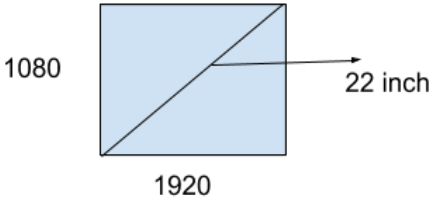
Step-1: To check the ratio [width/height= 1920 /1080 ]
Step-2: Ratio: 16/9.
Step-3: Using Pythagoras theorem (9x) 2 +(16x) 2 =(22) 2
x=19.17 inch
Question 42 |
Even when the screen is completely dark while the film is in motion, commercial motion pictures use
A | 32 frames per second or 101 screen illuminations per second |
B | 72 frames per second or 234 screen illuminations per second |
C | 8 frames per second or 32 screen illuminations per second |
D | 24 frames per second or 72 screen illuminations per second |
Question 42 Explanation:
→ Motion picture, also called film or movie, series of still photographs on film, projected in rapid succession onto a screen by means of light.
→ When a motion picture film is projected on a screen at the rate of at least 16 illuminations per second but the commercial motion pictures uses 24 frames per second or 72 screen illuminations per second.
→ Film Technology standard is 24 frames per second, a three bladed shutter and some dreamy motion blur, all projected as shadow and light on the side of a wall.
→ When a motion picture film is projected on a screen at the rate of at least 16 illuminations per second but the commercial motion pictures uses 24 frames per second or 72 screen illuminations per second.
→ Film Technology standard is 24 frames per second, a three bladed shutter and some dreamy motion blur, all projected as shadow and light on the side of a wall.
Question 43 |
The file size of a 640 by 480 pictures of 256 colours in a 8-bit resolution is
A | 300KB |
B | 900KB |
C | 128KB |
D | 1024KB |
Question 43 Explanation:
●Give picture size with 640 by 480 resolution with 256 colors per pixel.
●This implies 640 * 480 = 307,200 pixels. Recall that 256 values requires 8 bits of computer storage.
●Hence (307,200 pixels) * (8 bits per pixel) = 2,457,600 bits of storage.
●A common method for selling computer storage is in 8 bit groupings called bytes.
●Hence the picture would require (2,457,600 bits) / (8 bits per byte) = 307,200 bytes of computer storage.
●This implies 640 * 480 = 307,200 pixels. Recall that 256 values requires 8 bits of computer storage.
●Hence (307,200 pixels) * (8 bits per pixel) = 2,457,600 bits of storage.
●A common method for selling computer storage is in 8 bit groupings called bytes.
●Hence the picture would require (2,457,600 bits) / (8 bits per byte) = 307,200 bytes of computer storage.
Question 44 |
The process of producing bitmapped images from a view of 3-D models in a 3-D scene is called
A | Rendering |
B | Looping |
C | Cross dissolving |
D | Imaging |
Question 44 Explanation:
Rendering or image synthesis is the automatic process of generating a photorealistic or non-photorealistic image from a 2D or 3D model (or models in what collectively could be called a scene file) by means of computer programs.
Question 45 |
Which of the following is interactive?
A | A radio broadcast |
B | A talk show on TV |
C | A newspaper |
D | A computer game |
Question 45 Explanation:
Options A,B and C are not interactive , it will provide only information to the people. Where as Computer game in which computer user should interact with the computer in order to play the game
Question 46 |
While making bubbled lists, which of the following options are available?
A | Square,disc,tringle |
B | Triangle,disc,circle |
C | Triangle,square,circle |
D | Disc,square,circle |
Question 46 Explanation:
→ Disc: A filled circle
→ Circle : An unfilled circle
→ square : A filled square
→ Circle : An unfilled circle
→ square : A filled square
Question 47 |
MPEG involves both spatial compression and temporal compression. The spatial compression is similar to JPEG and temporal compression removes_____frames.
A | Voice |
B | Spatial |
C | Temporal |
D | Redundant |
Question 47 Explanation:
MPEG: The MPEG codec can only be used when the final video file will be in MPEG format (it is not compatible with other file types). It uses a lossy compression scheme (although it may be lossless at high-quality settings) and spatial and temporal compression. MPEG offers the best compression possible, but MPEGs are not yet as widely supported on the Web as other video formats.
Spatial compression:
Spatial (or intraframe) compression takes place on each individual frame of the video, compressing the pixel information as though it were a still image. JPEG, PNG and PICT files are an example of spatial compression.
It is known as the intraframe method.
Temporal compression:
It happens over a series of frames of the video. Temporal (or interframe) compression happens over a series of frames and takes advantage of areas of the image that remain unchanged from frame to frame, throwing out data for repeated pixels.
It is also called the interframe method.
Spatial compression:
Spatial (or intraframe) compression takes place on each individual frame of the video, compressing the pixel information as though it were a still image. JPEG, PNG and PICT files are an example of spatial compression.
It is known as the intraframe method.
Temporal compression:
It happens over a series of frames of the video. Temporal (or interframe) compression happens over a series of frames and takes advantage of areas of the image that remain unchanged from frame to frame, throwing out data for repeated pixels.
It is also called the interframe method.
Question 48 |
In which of the following, the density of the core remains constant from the center to the edges?
A | Single mode fiber |
B | Multimedia step-index fiber |
C | Multimode graded index fiber |
D | Single mode step index fiber |
Question 48 Explanation:
Multimode Step-index: In multimode step-index fiber, the density of the core remains constant from the center to the edges. A beam of light moves through this constant density in a straight line until it reaches the interface of the core and the cladding
Question 49 |
Which of the following is a special effect in motion pictures and animation that changes one image/picture into another through a seamless transition?
A | Modeling |
B | Morphing |
C | Animating |
D | Wrapping |
Question 49 Explanation:
→ Morphing is a special effect in motion pictures and animations that changes (or morphs) one image or shape into another through a seamless transition.
→ Morphing means stretching or as part of a fantasy or surreal sequence.
→ Morphing means stretching or as part of a fantasy or surreal sequence.
Question 50 |
Which of the following compression algorithms is used to generate a .png file?
A | LZ78 |
B | Deflate |
C | LZW |
D | Huffman |
Question 50 Explanation:
→ Deflate is a lossless data compression algorithm and associated file format that uses a combination of the LZ77 algorithm and Huffman coding.
→ An algorithm producing Deflate files is widely thought to be implementable in a manner not covered by patents.
→ This has led to its widespread use, for example in gzip compressed files, PNG image files and the ZIP file format for which Katz originally designed it.
→ An algorithm producing Deflate files is widely thought to be implementable in a manner not covered by patents.
→ This has led to its widespread use, for example in gzip compressed files, PNG image files and the ZIP file format for which Katz originally designed it.
Access subject wise (1000+) question and answers by becoming as a solutions adda PRO SUBSCRIBER with Ad-Free content
Register Now
You have completed
questions
question
Your score is
Correct
Wrong
Partial-Credit
You have not finished your quiz. If you leave this page, your progress will be lost.
Correct Answer
You Selected
Not Attempted
Final Score on Quiz
Attempted Questions Correct
Attempted Questions Wrong
Questions Not Attempted
Total Questions on Quiz
Question Details
Results
Date
Score
Hint
Time allowed
minutes
seconds
Time used
Answer Choice(s) Selected
Question Text
Need more practice!
Keep trying!
Not bad!
Good work!
Perfect!

